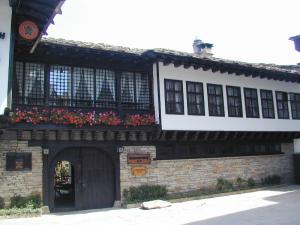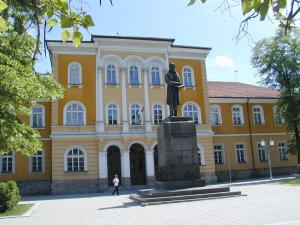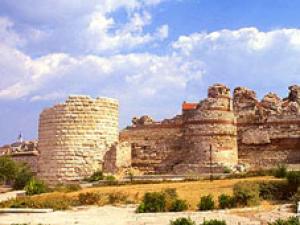Information about the region of Gabrovo
Gabrovo PropertiesThe town of Gabrovo has 67 350 inhabitants and is 390 metres above sea level. It is situated along the two banks of the Yantra River, at the northern foot of the Shipka Balkan Mountain (Central Stara Planina). It is situated 220 km north-east of Sofia, 274 km south-west of Varna, 150 km north-east of Plovdiv, 46 km south-west of Veliko Turnovo, 48 km north of Kazanlak and 28 km south-east of Sevlievo. It is situated in the immediate proximity of the geographical centre of Bulgaria and in itself is a centre of humour and jokes as well as a regional administrative centre.
At the end of the 12th century due to the proximity of the town to the capital of the Bulgarian state Turnovo, the handcrafts and trade developed here as well as crafts related to the maintenance and guard of the passes through the Balkan mountain - blacksmiths, armour and weapon smiths, etc.
 The first known name of the settlement dates back to 1430 (already under the Ottoman Rule) - Gabruva, and today?s name - Gabrovo appeared as late as the 17th century. The name comes from the horn-beam tree (Carpinus betulus, in Bulgarian ?gaber?). During the years of Ottoman Rule Gabrovo was a big craftsmanship and trade centre. During the 19th century 26 crafts were practiced here - blacksmiths (horseshoes), knives and cutlery, pottery, manufacture of braids, leather processing and tailoring, silkworm breeding and a lot of others. The first manufacturing enterprise Ivan K. Kalpazanov opened in 1860 ? a textile factory. In the same year Gabrovo was proclaimed a town. Felix Kanits said about it that during the 70-es of the 19th century ?Gabrovo is a big workshop? and that it is ?a town living on water?, having in mind the widely used waterpower. The good quality of the Gabrovo made articles was known all over the Ottoman Empire and even beyond it. There is a street in Bucharest now still named ?Gabroveni?.
The first known name of the settlement dates back to 1430 (already under the Ottoman Rule) - Gabruva, and today?s name - Gabrovo appeared as late as the 17th century. The name comes from the horn-beam tree (Carpinus betulus, in Bulgarian ?gaber?). During the years of Ottoman Rule Gabrovo was a big craftsmanship and trade centre. During the 19th century 26 crafts were practiced here - blacksmiths (horseshoes), knives and cutlery, pottery, manufacture of braids, leather processing and tailoring, silkworm breeding and a lot of others. The first manufacturing enterprise Ivan K. Kalpazanov opened in 1860 ? a textile factory. In the same year Gabrovo was proclaimed a town. Felix Kanits said about it that during the 70-es of the 19th century ?Gabrovo is a big workshop? and that it is ?a town living on water?, having in mind the widely used waterpower. The good quality of the Gabrovo made articles was known all over the Ottoman Empire and even beyond it. There is a street in Bucharest now still named ?Gabroveni?.The quick economic growth and the national revival were the reason for the opening of the first Bulgarian secular school called after the name of its founder - Vassil Aprilov as early as in 1835. In 1872 it grew into a secondary school and in 1889 it was called Aprilov?s High School, functioning up to date. Beautiful Revival houses, churches, bridges, drinking-fountains, a clock tower (1835) were built then. The inhabitants of the town took an active part in the Uprising of Captain Dyado (Grandfather) Nikola in 1856, in the Turnovo Uprising of 1862, in the detachments of armed volunteers of Hadzhi Dimitur and Stefan Karadzha (1868), of Hristo Botev (1876), of Tsanko Dyustabanov (1876 - completely formed in Gabrovo). In 1868 Levski set up a revolutionary committee here. The town is the birthplace of Vassil Aprilov, Tsanko Dyustabanov, Pop (Priest) Hariton, the composer Emanuil Manolov and a lot of others.
Gabrovo continued to develop as the biggest textile centre of Bulgaria after the Liberation and it was not by accident that it was nicknamed ?the Bulgarian Manchester?. The town has been famous for the stinginess and sharp-wittedness of its inhabitants from time immemorial due to which the unique in the world House of Humour and Satire is located here.
 The unique House of Humour and Satire is a place that you should visit. Works of authors from 153 countries are exhibited in 10 halls with an area of 8000 square metres. This House not only collects but also investigates and popularises humour and satire in all the genres. Every odd year the House and the whole town become the centre of the International Biennale of Humour and Satire in the Arts, which is a part of the big May Cultural Festivals of Gabrovo.
The unique House of Humour and Satire is a place that you should visit. Works of authors from 153 countries are exhibited in 10 halls with an area of 8000 square metres. This House not only collects but also investigates and popularises humour and satire in all the genres. Every odd year the House and the whole town become the centre of the International Biennale of Humour and Satire in the Arts, which is a part of the big May Cultural Festivals of Gabrovo.
The unique in south-eastern Europe open-air museum - the architectural ethnographic complex of Etura is situated at the distance of 8 km south of the centre of the town in the immediate proximity of the Etara quarter and past the Sivek River (at the distance of 3 km from the road-fork to Shipka). It is the most interesting place of interest in the town and one of the most visited site all over Bulgaria. Located over an area of 60 decares the complex lives the authentic life of a typical craftsmanship settlement from the period of Bulgarian Revival. The way Bulgarian people lived 150 years ago can be perceived and felt here. One can hear the rattle of wheels and mills moved by water, the whiz of the mills for woollen cloths and for flour. Metal ornaments, pottery articles, copper utensils, braids, hot buns and whatever else come out from the skillful hands of the masters there. The little cobblestone streets, the stone cheshmi (drinking-fountains), the gas lanterns, Sakov?s house, the house with the tavern, the clock tower and a lot of other authentic details complete the whole picture. All of these is predominantly the work of the great patriot Lazar Donkov who dedicated his life to this noble cause ? to create this authentic ethnographic complex. There is a town bus running to Etura.
The town Museum of History, The National Museum of Education and the Aprilov?s High School, in which a lot of well-known Bulgarians studied (Aleko Konstantinov, Emanuil Manolov and others). Master Gencho Kunev built it at the initiative and with the funds of the rich merchant, enlightener and scholar Vassil Aprilov.
The Hristo Tsokev Art Gallery exhibits Bulgarian and foreign works of art. Bayov Bridge, built in 1855. The Assumption Church (1865), whose icons and wood-carved iconostasis (work of masters from Tryavna) are among the masterpieces of Bulgarian art. The clock tower (1835, in the centre of the town), whose clockwork was made by by local blachsmiths, and its bell was made in Vienna. The cobblestone Opulchenska Street and the old commercial Radetski Street are of interest to the visitors, too.
The monument to Racho Kovacha (Racho the Blacksmith) - the legendary founder of the town. It is located on a small rocky island in the Yantra River (the central part of the town). The Aprilov drinking-fountain built up in 1762 by Krustio Aprilov, a relative of V. Aprilov. It has 2 drinking-founatin heads and an interesting decoration. The Planetarium and the Zoo are located in the direction of the Gradishte area.
Being a big cultural centre, Gabrovo nowadays has 3 professional theatres - the Racho Stoyanov Theatre of Drama, The Puppet Theatre and the Experimental Theatre of Satire and Variety.
Every year during August a Balkan youth festival is held in Gabrovo called ?Youth on the Balkans?, and at the end of September - the beginning of October the town hosts the ?Days of Chamber Music?.
Gabrovo is a university centre, too - the Higher Institute of Mechanical and Electrical Engineering (1963).
Railway and bus transport. There are regular bus lines to Sofia, Veliko Turnovo, Gorna Oryahovitsa, Kazanluk, Troyan, Tryavna, Sevlievo, Apriltsi, the Shipka Pass and a lot of other smaller settlements and recreation zones. The bus station is in the central part of the town. Gabrovo is the last station on the railway line of Vurbanovo - Gabrovo, a branch of the main line Russe - Gorna Oryahovitsa - Stara Zagora - Podkova. All trains stop at Vurbanovo Station and through it Gabrovo is connected to the national railway network. There is a town bus transport, too.
One can admire the panoramic view to the town and have a look at the ruins of the old fortress wall in the Gradishte area - at the distance of 3 km from Gabrovo.
The Assumption Sokolski Monastery (4 km from Etura and 12 km south-east from the centre of Gabrovo) was built in 1833 with donations by the citizens of Gabrovo and Bulgarians in immigration. Its foundation and activity further on are closely connected to the name of Yossif Sokolski. The Monastery turned into an educational centre and Neofit Bozveli was a teacher there. In 1856 the detachment of armed volunteers of Dyado Nikola found shelter here. After the defeat 8 of the revolutionaries were hanged in the cave by the monastery. The place of these gallows is a channel-house now and the hooks for the ropes are hammered into the wall. Later on (1868) Master Koliu Ficheto erected a stone drinking-fountain with eight fountain heads which slakes the thirst of the exhausted traveller. During the rebellious spring of 1876 the detachment of 220 rebels of Tsanko Dyustabanov was blessed in the monastery before it set off on the way to immortality. Before that the Apostle Vassil Levski found shelter here, too. During the Russian-Turkish War of Liberation the monastery was turned into a military hospital. A modest museum collection preserves relics from the struggles for enlightenment and freedom. Old icons painted by the hand of Zakhari Zograf complete the precious exhibits of the museum. There is bus transport available or one can walk to the museum from Etura along a marked track for 1-1.30 hours.
 The Liuliatsite Resort is situated at the distance of 15 km west of Gabrovo whose name is related to the abundance of lilac within the region. The climate is favourable to some pulmonary diseases. There is a rest house, private and institutional country-houses, catering establishments. A marked hiking track starts from here in the direction of the central ridge of Stara Planina which joins the Kom-Emine route along the ridge of Stara Planina Mountain. There is a regular bus transport.
The Liuliatsite Resort is situated at the distance of 15 km west of Gabrovo whose name is related to the abundance of lilac within the region. The climate is favourable to some pulmonary diseases. There is a rest house, private and institutional country-houses, catering establishments. A marked hiking track starts from here in the direction of the central ridge of Stara Planina which joins the Kom-Emine route along the ridge of Stara Planina Mountain. There is a regular bus transport.
Uzana Mountain Resort is situated at the distance of 22 km south-west of the town on the ridge of Stara Planina (Shipka Balkan Mountain) - there are institutional holiday houses, several hotels, 3 chalets, a ski-lift, a base of the Mountain Rescue Service, catering establishments. The geographic centre of Bulgaria is located within the region, too and is marked with a memorial sign. There are regular buses during the holidays.
The historical Shipka Pass is situated at the distance of 21 km south of Gabrovo and the Monument to Freedom is located above it. The historical Mt. Bouzloudzha is at the distance of 12 km east of the pass. All buses running between Gabrovo and Kazanluk stop at the Shipka Pass and there is no regular transport to Bouzloudzha. The village of Bozhentsi ? an architecture and ethnographic reserve is situated 15 km east of Gabrovo. Gabrovo is a key point of departure for hiking routes around the Shipka Balkan Mountain.
Gabrovo Properties

